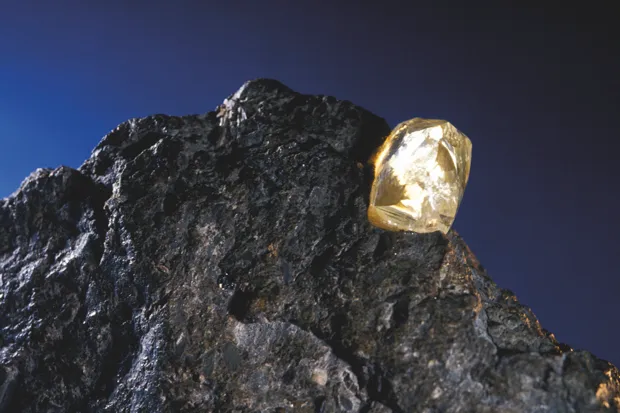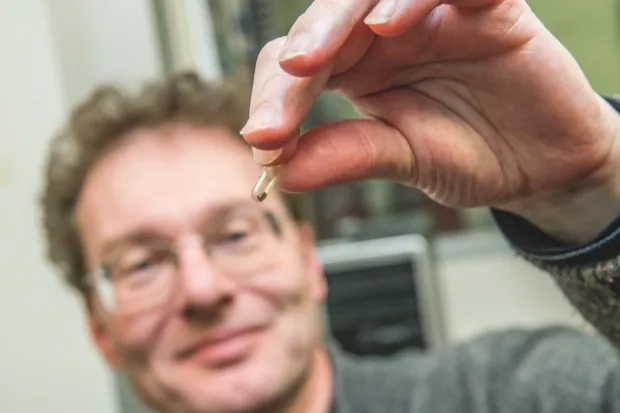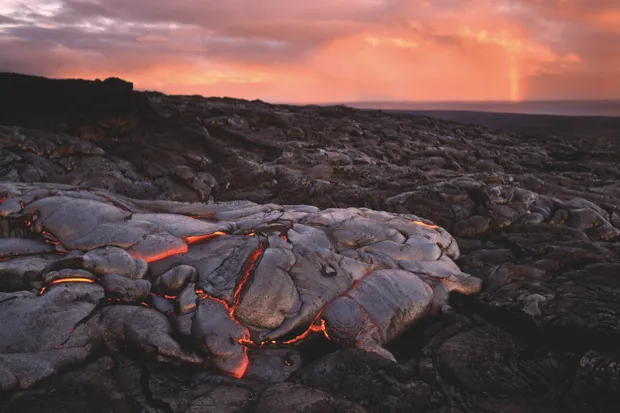Deep below the surface of our planet, an ocean lurks. It’s a secret world of water we only know about because of an unlikely messenger: diamonds.
The rocks we see and interact with every day – mountain ranges, crumbling coastal cliffs, maybe the soft sediments and soils that line valley floors – are only a small portion of all the rocks on Earth. In-between the surface of the planet and the iron-rich core is the mantle, a warm, thick, gooey layer of rocks that flows like plastic. This is where the diamonds grow, hundreds of kilometres down. As the gemstones form, they freeze a moment of deep mantle geology, and when they arrive at the surface, scientists can poke and prod at them to understand more about the conditions within the planet. From the stories those diamonds tell, the mantle is very, very wet, and may contain as much – or more – water than all of the Earth’s oceans put together.
Water is one of the key factors that sets Earth apart from other worlds, and a prime target when hunting for possible life out in the Universe. Could these diamonds offer us insight into the formation of Earth and other planetary bodies?
Diamonds are a geologist’s best friend
Diamonds can grow as either fibrous snowflakes or layered octahedrals, explains geologist Prof Maya Kopylova from the University of British Columbia. When fibrous diamonds form, the long crystal strands catch and tangle with their surroundings, weaving tiny droplets of nearby fluids into their structure. The enormous pressure and high temperature of the mantle pushes these fluids to a supercritical tipping point between liquid and gas that can dissolve nearby rock and gas. These dissolved substances are then incorporated into a forming diamond to ensnare a perfect, tiny sample of the mantle. “As diamonds grow, they can trap materials that are surrounding them,” says Dr Kim Tait, the curator of mineralogy at the Royal Ontario Museum. “This is a great opportunity to directly look at some of the materials that have formed deep within Earth.”

These inclusions are minute – fractions of the diameter of a human hair, and rarely visible to the naked eye. While these dark, scruffy-looking diamonds are no good for jewellery, for a geologist they are precious windows into the conditions deep inside Earth. “In a perfect world, we would drill down to the core and take samples of all the material, but that’s just not feasible in real life,” says Tait. Instead, scientists have to wait for the diamonds to arrive at the surface by natural geological activity.
Yet a diamond’s journey to the surface is not simple. If diamonds are slowly carried up from the mantle over millions of years of mountain-formation, they’ll degrade into graphite long before they reach us. According to Kopylova, intact diamonds are brought to the surface only by cratons or kimberlite rock formations. Cratons are old, stable parts of =the continental plates with little tectonic activity, while kimberlites are a rare type of volcanic eruption that act as conduits extracting magma from the deep mantle directly to the surface. “Kimberlite pipes just shoot from 400 kilometres deep up to the surface within days!” says Kopylova. This express trip from mantle to surface means that diamonds don’t have a chance to decompose into graphite. It is for this reason that many of the world’s most important diamond mines are based around kimberlite pipes.
This speedy ascent paired with the extreme hardness of diamonds is what makes them capable of carrying snippets of the mantle up to the surface, and is why they are so useful for geologists who study the deep Earth. “Diamonds are an insulating vessel that can keep the internal pressure that will be lost in other deep-mantle minerals,” says Kopylova. “We can look at garnets, for example, but garnet is not as good at keeping the pressure inside of the crystal still at high pressure. Diamond is unique.”
Ice, ice, baby
For decades, researchers have studied diamonds to help them understand the chemistry and geology deep below our feet. But in March 2018 a team led by Prof Oliver Tschauner, a mineralogist from the University of Nevada, Las Vegas, found something utterly unexpected when they X-rayed a diamond extracted from Africa: ice.
When water freezes, it crystallises into ice. But not all ice is like the stuff that we find in snowbanks or ice cubes. Under extreme temperatures and pressures, ice can take on more exotic structures where its hydrogen and oxygen atoms will bond with increasing complexity. Most of what we know about these exotic phases of ice comes from carefully growing samples in laboratories under artificial conditions.
Almost all the ice you encounter on a daily basis is hexagonal ice Ih, with a few traces of its cubical cousin ice Ic in the upper atmosphere. Scientists first started noticing that ice frozen under higher pressures in the lab took on different crystal structures as early as 1900, with each new exotic variety counting up as ice II, III, and so on. The ice found trapped within the newly found diamond is ice VII. While it is the first time one of these unusual phases has been found naturally on Earth, scientists have long-theorised that particular varieties of water ice might form on other planetary bodies, maybe even within the icy moons of our Solar System. Therefore, by discovering tiny crystals of ice VII within this diamond, scientists have revealed an unexpected link between Earth and other worlds.
“Ultimately this diamond represents a very unusual form of water that we do not normally see at the [Earth’s] surface because the pressure required to make it is simply much greater than the ambient pressures,” says Prof George Rossman, a mineralogist at California Institute of Technology.
Locked up
The ice VII didn’t form at the same time as its encasing diamond. “This fluid was trapped almost like a bubble in the diamond,” says Tait, who is responsible for preserving the sample. Originally as the diamond grew hundreds of kilometres deep within the Earth, the inclusion was a supercritical fluid on the verge between liquid and gas, and was too hot to crystallise into ice. If the diamond had stayed buried within the planet, this is where the story would have ended. But the diamond was expelled from the depths, and dropped into our much chillier surface conditions.
“When the diamond came up to the surface, it still maintained a high internal pressure squeezing the water under pressure somewhat akin to what they were experiencing deep in the Earth,” explains Rossman. “As it rose to the surface, the diamond cooled. Only then did the water crystallise into ice VII.”

Any time that a new material is discovered, scientists use that first sample as a type specimen that is preserved and protected. The Royal Ontario Museum houses roughly 200 type specimens, including the ice VII diamond. The diamond acts as a tiny pressure chamber keeping the ice VII stable, so the museum doesn’t need to keep it cool or take any other special actions to keep it safe. “It’s completely stable within its trapped host,” Tait says. But that doesn’t mean it’s just sitting on a shelf in a storage room. “All of our type materials are in a lockable vault because they are that important to us,” says Tait.
Despite the astonishing discovery that such an exotic form of ice can form in nature, actually seeing the diamond is a bit disappointing, Tait admits. “Our photographer said, ‘Let’s take a picture of it.’ I showed it to them and they’re like, ‘Oh.’” Tait laughs. “I wish it was a little bit more exciting to see.” Each inclusion is just a few microns large and holds even smaller microcrystals of ice VII and other minerals.
Plates and planets
While it might not be photogenic, this diamond with its unique passenger of ice VII adds a new element to the complicated dance of water within Earth and other worlds. Like Earth, the rest of the planets in our Solar System were bombarded with comets and swathed in hydrogen gas when they were forming, so they should also have plenty of water locked within the rocks. Yet as far as we know, Earth is the only planet that has plate tectonics to link the water cycle from its surface to its depths. The Earth’s crust is made of rigid yet flexible plates that are constantly moving at about the same speed as our fingernails grow. These plates collide and crumple to form mountain ranges, but when continent meets ocean, the denser and colder oceanic plate is shoved deep into the mantle, carrying with it cold, wet rocks – and therefore water – from the ocean floor.

“Oceanic sediment is constantly being brought down into the deep Earth where the water from these sediments is released,” says Rossman. Then, the water interacts with minerals, either becoming incorporated into their structure or getting trapped as inclusions in diamonds and other crystals. This infusion of water reduces the melting point of the surrounding rock, liquefying it into magma that erupts as volcanoes. By finding an exotic variety of ice lurking within a diamond, we have a unique window into the particular blend of temperature and pressure at depth, a bespoke sample collector offering insight into the heart of our planet.
“If we could take an ice cream scoop and scoop out all of these minerals that have trace amounts of bound water in them, and then squeeze the water out, there is probably as much water in the upper mantle tied up in these minerals is there is in all of the oceans of the world today,” says Rossman. “The upper mantle is a reservoir of water, potentially as great as every bit of water we have in the oceans.”
The story of water is a vast dance, spanning hundreds of kilometres and billions of years, a story of clouds and ocean and icebergs, but now we know it’s also a story of fire and diamonds and ice.
This is an extract from issue 330 of BBC Focus magazine.
Subscribe and get the full article delivered to your door, or download the BBC Focus app to read it on your smartphone or tablet. Find out more
Follow Science Focus onTwitter,Facebook, Instagramand Flipboard
